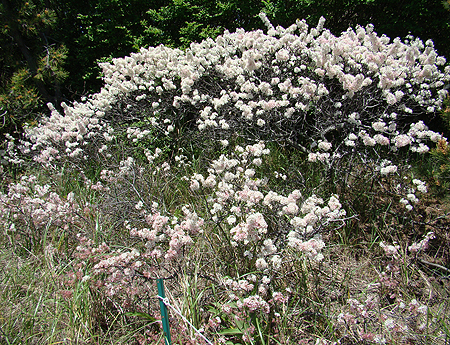

In the late 1970s, I was just a neophyte to gardening in the Hamptons.
I’d done plenty of gardening in containers. And I was spoiled by the deep and rich soil of the north shore of Nassau County where I grew up. As a result, this business of seaside gardening was totally new to me.
But my lessons in East End gardening began when I found a house to rent in Shinnecock Hills. It was on a strange piece of land surrounded by what I could only describe as a maritime prairie. The 20 to 30 acres to the south of the house was an abandoned part of the Shinnecock Golf Club that hadn’t been tended in generations and it had reverted to a wonderfully wild landscape.
The plant community was dominated by the original golf course grasses gone wild, but there were also common pitch pines, yucca, some patches of low bush blueberries, shad bush, prickly pear cactus and some shrubs that flowered in early May and had this small ping pong ball-sized fruit that showed up in August, colored in purple to red and in some cases tinges of orange.
I paid little attention to this shrub until my first August at the house. I remember looking out my kitchen window one warm day, toward the open rolling meadow, where several women were walking through the field with small plastic buckets. I had no clue what they were doing, let alone who they were, and my curiosity was piqued as they descended to the back of my property and began to do something to these shrubs.
It turned out that one of the women was my neighbor. She was with several of her friends going through the fields picking the ripening beach plums, or
prunus maritima
, off the shrubs. She explained that for generations East Enders went out into the wilds of the sandy Hamptons in August to collect these fruits, which they then turned into a juice and made beach plum jams and jellies. The fruit can also be used to make beach plum candies and beach plum cordials.
The beach plum is native to the east coast, from Virginia up to Maine and beyond. It also occurs in a couple of places along the Great Lakes and in one or two spots along the coast in the Pacific Northwest. It’s considered a shrub or small tree and it’s at home in full sun and sandy soil. It is incredibly drought-, wind- and salt spray-tolerant. Its habit is somewhat variable and you can find it growing in the ocean-facing dunes and on the barrier beach islands, as well as along the beaches and bluffs of the bays and shoreline along Long Island Sound.
In extremely windy locations the shrub grows short and tight, often only getting 3 or 4 feet tall. But it can mature to a substantial plant 12 to 15 feet tall with a spread of up to 20 feet—when it’s grown away from the shoreline, but still in full sun and sandy, nutrient-starved soils.
The plants flower from late April to mid May with small white flowers that fade to pink. Some years the flowers can be so dense and white that on a sunny day they make the most incredible display.
Not surprisingly, the location of the shrubs can have a great deal to do with flowering time. I’ve noticed that the trees along Montauk Highway in Southampton can flower a week earlier than those out on Meadow Lane just off the bay while plants in Flanders and Riverhead will flower even a week earlier.
In the wild, the plants can be, well, wild looking. But in the landscape, they can be pruned and shaped over a period of years.
The largest beach plums that I was aware of were located at Southampton College right where Tuckahoe Road passes the old gym. These trees must have been 50 to 80 years old and were magnificent specimens that grew 15 feet tall with a spread of at least 20 feet. Unfortunately, the trees must have been seen by some unknowing administrator from Stony Brook as “not in keeping with the new image,” as one was unceremoniously cut down and the other is now only a standing carcass.
The harvesting of the fruit and the production of the juice that is used for a number of products has been a cottage industry for years. Locally you can find beach plum products at the Briermere Farm (briermere.com) in Riverhead.
A number of years ago, Cornell Cooperative Extension received a grant from the Sustainable Agriculture Research and Education program to coordinate and publicize the growing of beach plums. Learn about this project at beachplum.cornell.edu. Other interesting sources of beach plum information come from The New York Times (there have been a few articles about using the fruit) and National Public Radio (there was a great segment last year that included recipes for beach plum jelly, beach plum drops and beach plum cordials).
Warning: The fruit is not always tasty right off the tree. But occasionally when picked perfectly ripe, you’ll find them, well, interesting.
In the landscape, this is the ultimate shrub if you’re looking for a plant that requires virtually no care, has few if any disease and insect problems and grows in sand. But it’s not easy to transplant unless you are moving a young plant and do it while it’s dormant.
Beach plum plants are hard to find at local nurseries, but they are available for those willing to search. There are also mail-order sources for the plants and there are even some named varieties available. Fairweather Gardens in New Jersey (fairweathergardens.com) sells 24- to 30-inch plants for $19.95, but they are sold out for this season. They might be taking orders for next year.
Another option for the gardener with patience is to grow the trees from seed. That would be the plum pit. When the fruit is ripe, the pulp is removed (what we call the fruit) revealing the seed or pit. The pit is then stored for several days at room temperature allowing it to dry. Then the seed is put in an airtight jar in the refrigerator.
The seed will germinate only when it’s stratified or chilled and this is done by planting the seed in moist peat or sphagnum and stored in the refrigerator at 40 degrees for five months. There are more details at the Cornell site under the Frequently Asked Questions tab.
Now, if you’re thinking: “if this plant does so well in the sand near the ocean, just think how well it will do in my great soil with some fertilizer and irrigation,” think again. When coddled, fertilized, irrigated and generally over-cared for, this plant quickly looks awful and deteriorates. The theory is that salt and salt spray is critical to this plant in controlling the diseases and fruit fungus that are endemic to other plum species.
Up for the challenge? This is really a wonderful plant that you can’t beat for beauty, ecology and sustainability. Plant some seeds in your sandy yard and get surprised in a few years. You can’t get more natural. Keep growing.
 More Posts from Andrew Messinger
More Posts from Andrew Messinger